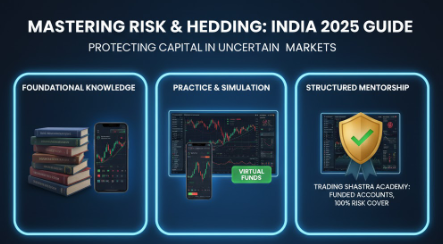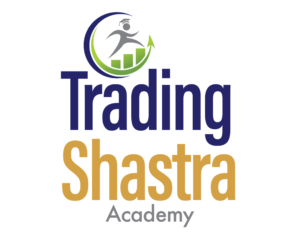- Sector -2, B Block Noida-201301
- info@tradingshastra.com
Where to Learn Risk Management and Hedging Strategies — Complete 2025 Guide
Every successful trader knows that profits are not just about predicting prices but about controlling risks. Risk management and hedging strategies protect traders from uncertainty. In 2025, Indian learners have many ways to gain these skills — from books and simulators to structured mentorship at Trading Shastra Academy.

What is Risk Management in Trading?
Risk management means controlling the downside while allowing growth. It ensures one mistake does not wipe out your account. Traders use tools like stop-loss, position sizing, and diversification. Learning how to manage exposure early is the difference between consistent profits and unpredictable losses in the long run.
Table 1: Common Risk Management Tools
| Tool | Purpose | Example Application |
|---|---|---|
| Stop-Loss Orders | Limit downside per trade | Sell stock at 5% fall |
| Position Sizing | Control allocation per trade | 2% risk of portfolio |
| Diversification | Spread risk across assets | Equity + Bonds mix |
| Risk-Reward Ratio | Evaluate profit vs risk potential | 2:1 ratio strategy |
What is a Hedging Strategy?
Hedging uses instruments like options, futures, or pairs to reduce portfolio risk. For example, a trader holding equities can buy Nifty PUT options to protect against a market drop. Hedging does not guarantee profit but limits downside, making it essential for sustainable trading strategies.
Table 2: Popular Hedging Instruments
| Instrument | How It Works | Typical Use Case |
|---|---|---|
| Options | Buy PUTs or SELL CALLs | Protect equity holdings |
| Futures | Opposite trade to existing asset | Hedge stock positions |
| Pairs Trade | Long one, short another | Reduce sector-specific risk |
| ETFs | Inverse index funds | Hedge against market falls |
Why Traders Must Learn Risk Management & Hedging Early
Without these skills, traders face overexposure and emotional decision-making. Small mistakes can cause large drawdowns. With proper hedging, losses are minimized, and confidence grows.
Fact: Over 80% of professional traders use hedging strategies regularly to protect their portfolios. This highlights why structured learning in risk management is critical.
Best Ways to Learn Risk Management & Hedging
1. Books & Online Resources
Start with books like “Options, Futures, and Other Derivatives” by John C. Hull. Explore SEBI and NSE’s free educational modules. These give theoretical understanding but lack hands-on practice, so learners must move beyond reading for practical mastery.
2. Virtual Practice with Options Simulators
Platforms like Sensibull Virtual and Moneybhai allow practice trades without risking money. They provide a sandbox environment where traders can experiment with hedging strategies. While useful, simulators cannot replicate real emotions. For that, institutes like Trading Shastra Academy provide supervised live-market exposure.
3. Mentorship & Live Training Programs
Self-study is slow and error-prone. Mentorship helps learners apply theories in real markets. Under a mentor, students learn adjustments, discipline, and psychology. At Trading Shastra Academy, students trade with institute-funded capital, and 100% risk coverage ensures mistakes do not cost personal money.
4. Join a Specialized Academy
General courses cover basics, but hedging requires specialized training. Trading Shastra Academy offers unique programs in options hedging, arbitrage, and adaptive strategies. Students practice with funded capital, with risk completely covered by the institute, making it one of the safest ways to master advanced strategies in India.
Step-by-Step Learning Roadmap
Building hedging skills takes a structured roadmap. Learners should start with basics, understand option Greeks, practice virtually, backtest strategies, and finally transition into live supervised trading.
Table 3: Learning Roadmap for Risk Management & Hedging
| Stage | Focus Area | Method | Duration |
|---|---|---|---|
| Basics | Options and risk concepts | Books, SEBI modules | 1 Month |
| Understanding Greeks | Delta, Gamma, Vega, Theta | Online resources, simulators | 1–2 Months |
| Virtual Practice | Paper hedging strategies | Moneybhai, Sensibull Virtual | 1 Month |
| Strategy Backtesting | Test historical data | TradingView, simulations | 1 Month |
| Live Mentored Trading | Hedging in live markets | Trading Shastra Academy | 2–3 Months |
Conclusion
Without risk management, trading is gambling. With hedging, trading becomes systematic and safe. Start with free resources and virtual practice, but the real edge comes from structured programs. Trading Shastra Academy provides funded accounts, mentorship, and 100% risk coverage, making it the most reliable pathway to mastering hedging strategies in 2025.
Frequently Asked Questions
Q1: What is the difference between risk management and hedging?
Risk management is the broader practice of controlling exposure using rules like stop-loss and position sizing. Hedging is a focused technique where instruments such as options or futures are applied to protect a portfolio from adverse movements.
Q2: Can beginners learn hedging strategies?
Yes. Beginners can start with theoretical knowledge, practice on simulators, and gradually move to supervised programs. With structured learning, even newcomers can understand how hedging strategies protect positions in the market.
Q3: Where can I learn options hedging in India?
Options hedging can be learned through academies, mentorship programs, and structured courses. Trading Shastra Academy is one institute that provides focused training on options, hedging, and adaptive strategies with guided live practice.
Q4: Why is risk management important in stock market trading?
Risk management ensures traders protect their capital during uncertain market phases. By limiting losses and maintaining balance, it helps build discipline and long-term sustainability in trading activity.
Q5: How long does it take to learn hedging strategies?
It usually takes three to six months of structured practice to build a strong foundation in hedging. This includes learning option Greeks, backtesting strategies, and applying them under supervised market conditions.
Trading Shastra Academy, B-11, Sector 2, Noida – 201301
🌐 www.tradingshastra.com | 📧 info@tradingshastra.com | 📱 +91 9717333901
Disclaimer: This blog is for educational purposes only. Stock market investments are subject to risks. Please do thorough research before investing.

